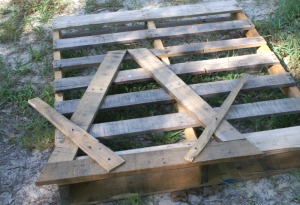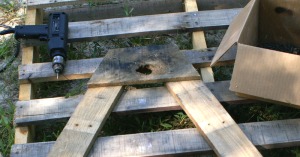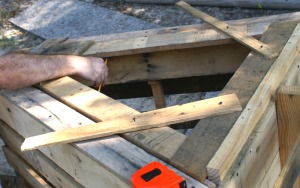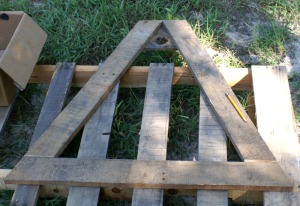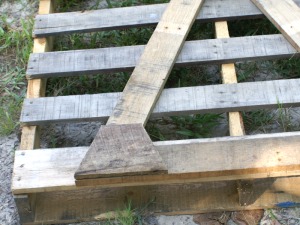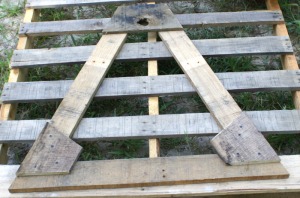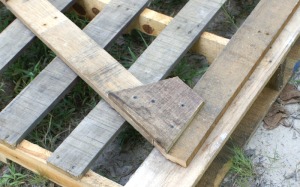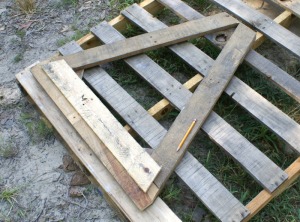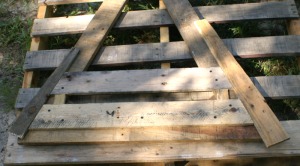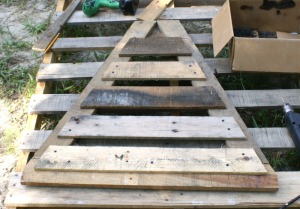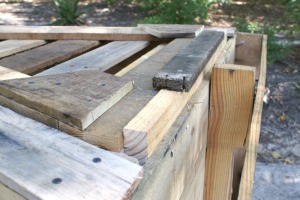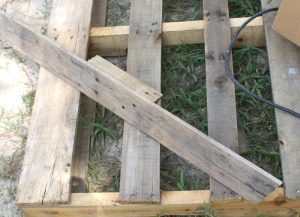Buy the Book
Subscribe to Updates
Who Are the Monkeys?
Inside the Book
Resources for Readers
Reviews
Bonus Tom Articles
Facebook Fan Page
Contact Us
Publisher

Pygmy Goat Pallet House
Finish the Door
Finish the Door
Contents
Introduction
Prep Work
The Foundation
Side Walls
Front Door Frame
Finish the Door
Back Wall
Roofing
Finishing the Door and the Front Wall
|
In the previous section, we framed in the door. In this section, we will finish the door, and finish the front wall.
To start, remove the door from the house and place it on a pallet, as shown to the left. Make sure all three pieces of the door are firmly supported by a good quality pallet on level ground, we're going to be leaning on it pretty hard as we add the next few pieces. As shown to the right, we've now added a door header. This piece fits flush to the top and sides of the door sides, and is mitered accordingly. For fun, we've selected a piece with an interesting knot hole, and centered that. This piece is held with four of the longer drywall screws if thickness permits with out penetration of the far side, or the shorter screws if not. To prevent the header from splitting, we've used pilot holes here. We've also avoided conspicuous knot holes in the header piece. |
|
At this point, test-fit the door back in the frame just to be sure. Adjust accordingly if it sticks anywhere. Then, with the door centered in the frame, reach inside the frame and mark the insides of both jambs about half-way up the piece for a few inches, as shown to the left.
Then, remove the framing scraps and place the pieces face down on the working pallet, as shown to the right. We're about to add some cross pieces to the back of the door, but we don't want any of them to interfere with our jambs. The pencil marks are barely visible in the enlargement, so we've placed a pencil along them on one side for clarity. We'll start adding slats to the back, but first we need to secure the sides to the bottom. |
|
Flip the whole door over, now with the header facing up, and reposition the footer. Select a wide slat from your pile, and cut from it a mitered piece as shown to the left. The exact dimensions don't matter much, but we started the right miter from the width of the side. We might be tempted to go ahead and screw the piece down as it sits, but we can't do this for two reasons.
First, ignoring the sawmill marks on the side, the grain of this piece runs horizontally. If we attached it in the orientation shown, it would split under only a very few head butts. Overall the door will be plenty strong by the time we're done, but I can't help myself. Second, we're going to add a reverse jamb at the end of the sill to keep goat-boy from knocking it off the sill. So, we can't place any braces on the bottom inch and a half of the outside of the door. This is similar in principle to avoiding the jamb area on the back of the sides. |
|
To the right we see the brace rotated into position, and offset an inch and a half from the bottom of the door. Four long drywall screws (unless these penetrate) hold the brace, two into each underlying piece. Both the left and right braces are shown for completeness.
Note that the grain is now oriented across the joint, resulting in a stronger connection. Also, no two screws hit the same grain lines, and we've pilot-drilled to further protect against splitting. Next, haul the entire assembly over to the miter saw, and place the bottom against the back guard. Trim the corners from the bottom using a right angle cut, as shown to the left. Do this for both sides. This cut will make the door a little easier to position past the reverse jamb we'll add soon. Also, in this view you can see that the corner braces are flush with the edge of the door. |
|
We can now start tiling the back with cross slats. The first one is the most critical as it ties the bottom and sides together with even more strength, and starts the pattern for the later slats.
We've started this cross-slat parallel to the bottom, and high enough that we can tie into the sides with a couple of screws. Also, note that the slat is short enough to not violate the jamb lines, with a little more clearance added for expansion, etc. The pencil in the photo is a reminder of the jamb lines we scribed earlier. We've also drilled pilot holes for the screws near the end of the slats to prevent splitting. To the left we've added the second slat. We've used a couple of contrivances to help our positioning. First, we've cut a couple of little blocks an inch and a half long. These are used to provide a consistent spacing for all our slats. Next, we've used two pieces of scrap as straight-edges to mark the pieces to length and to position them before screwing. These guides aren't tacked down, they are just lying in place. They also help determine whether we're trending in the right direction, or are in danger of violating our jamb lines. Note that we've put five drywall screws into the bottom slat, and four into the second slat. Again, drill pilot holes for screws near the end of the cross slats. |
|
To the right, we see the completed door, with correctly positioned slats all the way up to the header.
To the left, we've placed the door on the house, and now install the reverse jamb. The reverse jamb will prevent goat-boy from hammering the door loose at the bottom, since goats strike low. Select a relatively narrow slat for this purpose. There should be plenty of clearance for the corner braces. Note also that the bottom of the reverse jamb is flush with the bottom of the sill. If necessary, we can bring the bottom of the reverse jamb down to flush with the bottom edge of the bottom slat. The important feature is to not obstruct pallet-handling forks. |
|
Secure the reverse jamb with four small deck screws as shown above. Pilot holes are an absolute must with such a narrow and high-load piece. Try to avoid putting more than one screw on the same grain line.
The last two items to finish this wall are the medieval latch blocks and the last wall slat at the top above the door header. For the latch blocks, miter cut two chunks of rail, about eight inches in slant length. As shown to the left, place these two blocks on the side slats, just below the screws attaching the side slats to the side rails at positions level with each other if the house were standing on its base. Mark these positions well. Placing these blocks close to the middle rail screws gives us a lot of strength versus an angry goat. Leave enough space for your drill to operate. Also, we've used semi-dimensional rail here, but any chunky rail will work. Try to choose a rail segment that is equal to, or thinner, in width as the side slats. Next, remove the side slats (that's why we only tacked them before), and drive four long drywall screws into each block from the back of the side slats, as shown to the right. The drill cord in the photo suggests to pilot drill these holes, since some of the screws may risk splitting the latch block. Now, place the side rails back on the wall, and secure with small deck screws, replacing the temporary long drywall screws we had been using. This makes sure that the larger deck screws keep these pieces snug, treating the drywall screw holes as their own pilot holes. Also, strategically place a few long drywall screws on the outer edge of the side rails if needed. Don't forget to pilot drill. Now, miter cut two pieces of some good quality slat material, about twelve inches in slant length, and secure these pieces to the latch blocks as shown. Again, we've used four long drywall screws to defeat goat ramming. Position these pieces flush with the sides and bottom of the latch blocks. The last piece of the front wall is the final slat above the door header. Use the same guide blocks for the door to position this last slat, shown to the left of the door header in the last photo. Secure with long deck screws to the jamb slats, or to the top rails if possible. Be sure to pilot drill! Whew! Well, we've just finished the most complicated portion of the goat house. It's all downhill from here. Take a break, and then let's get started on the back wall. |
Shop our

Online Store
or

or
Get it on Kindle
